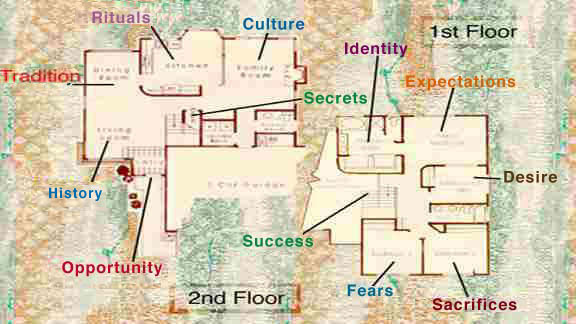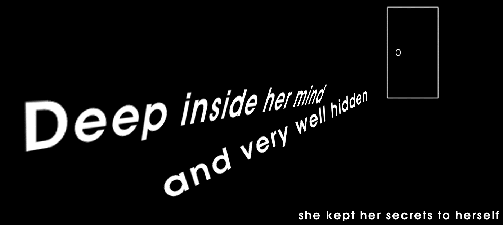A R T I S T STATEMENT A View of American Assimilation
From a Mexican-American PerspectiveSometimes I feel challenged as an individual born in the U.S. because I do not always feel completely American. This feeling has a direct impact on the images I create because it causes me to look inward to my own cultural base. In doing so I discover reasons for my life, such as why I have to create art.
A major turning point in my art making occured during the mid 90s when I discovered the Internet had become a new form of artistic expression. This was a very exciting discovery because the Internet offered artists an opportunity to reach a global audience. Immediately I began investigating the possibilities of creating reflections of the past, while exploring new understandings of the present with the use of new technology (the Internet) and autobiography. By the early spring of 1995, I began developing the substructure for Glass Houses, a multi-layered, interactive website.
Glass Houses is comprised of 32 linked screens that take approximately one hour to view. It is comprised of intimate stories, photographs, art work and sound files that serve as a vehicle to explore contemporary themes based on the complexities of cultural identity, gender issues, feminist concerns, assimilation, and the fear of becoming disenfranchised from one's cultural roots. It is based on my mother's life experience as a Mexican immigrant who settled in the U.S. with a dream of attaining a better lifestyle for herself and her family. In a critical way Glass Houses offers the viewer an intimate look at the impact this created in my life.
I created Glass Houses with the intent of introducing a voice for the "modern" Chicana living in the suburbs ( I use the term modern before Chicana to focus on the ideologies of the changing Chicana feminism in the 90s). As I developed the content for Glass Houses I envisioned inspiring the need for an open-minded society: one that could embrace cultural sensitity.
Using the structural floor plan of my own home, I designed a doormat (shown above) that could serve as a metaphor to explore a variety of themes associated with daily living such as: fears, ritual, tradition opportunity, and desires. Beneath the doormat is a set of keys and instructions that can be accessed by using the computer mouse. Upon accessing the keys the houseguest/viewer follows a linear path of seven individual screens that are each linked to the remaining screens of the website. As the houseguest navigates through the rooms, an autobiographical narrative reveals: how I learned to embrace my biculturalism, the impact of my mother's attempt to pass me off as a "white girl", reflections of the "Chicana(o)" suburban life experience, and the influence of popular culture in our lives.
My mother wanted me to live like an "American" with all the rights and privileges and no discrimination. Because I was fair-skinned and light-haired she thought it would be much easier for me.
Looking back on the beginning stages, I recall taking a modest pace in developing the content because I wanted Glass Houses to be more than just a vehicle for expressing my struggles for personal identity into the public domain of the Internet. I believed I was creating a vehicle that would invite a global dialogue with regard to contempory themes such as race, class, acculturation, and nationalism . . .
As we crossed the Mexican border, the border patrol would ask me my citizenship. I would reply, "American" because my parents taught me to say that. But in California, people would ask me "What are you?" I guess because they didn't quite know how to ask "Are you American?" I would proudly reply, "Mexican". It wasn't until I became a teenager that I claimed I was "Mexican-American".
At times it was a very difficult process finding the perfect words to convey my families' personal histories. There were even occasions when I found it necessary to leave my work in progress for a month or two as a means of distancing myself from the pain and discomfort I was ultimately creating for myself as a woman and mother still struggling with identity issues for herself and her own children . . .
How do we survive in a world driven by assimilation
and maintain our cultural identity?As a web author I felt motivated to challenge the cold and impersonal environment often associated with the computer. "Is it possible to introduce a private and intimate experience for the houseguest/viewer? Is it possible to offer a critical examination based on of the relationship between public and private space with an interactive experience on-line?" It made sense to me that these possibilities did exist after observing (at an art opening) my houseguests that began the tour by selecting the closet, where secrets are hidden . . .
Carrying out my vision for the construction of the website involved many complicated steps. Since I honestly did not know exactly where or how to begin, I started by keeping a diary of my remembrances as a small child. I then borrowed photographs from my mother's family albums and held interviews with my mother and other family members. As I gathered my findings I began writing a hypertext computer language (HTML) and created a linkage between the text and a series of black and white photographs, color photographs and artwork which I had scanned and imported into the website with the use of a variety of software programs. Some of the photographs and artwork were digitally enhanced or created with the use of Adobe Photoshop and Illustrator. To encourage a global dialogue I even established a message center located in the kitchen where the houseguest/viewer can leave me personal e-mail message or they can post a public comment.What surprised me the most about the impact of this website was the response I received from my mother. She honestly did not understand the concepts and ideas I was exploring. After a second attempt to explain to her the purpose of the work we sat down at my computer desk and accessed the first draft. She had never used a computer and so I helped her navigate through the screens. I watched and listened to my mother as she read each page out loud. When the photograph of my father sitting on the chair in the living room appeared her eyes swelled with tears till they began to roll down her face . . .
I remember my father was usually exhausted after a hard day's work of manual labor. For six months he played Mr. Mom during the holidays because a hateful 'white' neighbor reported to the authorities that my mother was undocumented. I was only seven years old when my mother was deported, my brother was six. The Christmas tree stayed up until mom returned home in April of the following year.
Even though I had given considerable thought to how my mother might respond I never expected anything like this to happen. At that very moment I felt heartless and her reactions forced me to seriously question my personal motivations for wanting to expose her personal experiences to a world of strangers. After feeling my mother's pain I questioned whether or not to finish what I had already begun. But something deep inside my heart told me I had to continue because I truly believed one day my mother would understand why I needed to create Glass Houses.
Immediately after the website was posted on-line I began receiving correspondence from my houseguests. Each time I received a public comment or personal e-mail message I would share it with my mother. . . .
The most important thing that struck me about your project is how personal it was. it really lets you in to your life and made me feel less lonely being in the house with you and your family, it was intimate but I didnt feel 'funny' just welcome and for that I thank and applaude you, it is a hard thing to accomplish, i got to be intimate without the sensation of being an intruder.-private email message submitted by a houseguestAs I received more messages I would download copies and we would read them together . . .
" I too was 'taught' to say 'American' when coming back from el centro in Juarez after visiting my grandparent's other home. I would ask why I could not say 'Mexican' to the officer and the answer was that if I did I would be arrested and put in jail. From then on I would never forget to carry my 'Pasaporte' or 'Papeles'. I too have worries on whether our history, culture, and struggles will be passed on down our family by those to come. I have two older step stepbrothers and two older stepsisters which do not consider themselves Mexican or Chicano. Their heritage is slowly being lost. Three of them do not speak Spanish and have lost both of their parent's beautiful and humble roots in being assimilated and Americanized. It is through such touching work as yours that much can be shared or questioned, on our identity, culture, and past.
-public comment posted on-line
Sometimes as we read them to each other tears roll down our faces . . .Thank you for sharing. As a "melting pot caucasian American" I envy your sense of heritage and desire to share it with your children, I wish I had such a treasure to share with mine. I don't know what is right or wrong, but sometimes, I think as "Americans", the end to discrimination will only occur when we are all mixed into beautiful shades of tan.
-private email message submitted by a houseguestI am grateful to my mother for allowing me to share the intimate details of her life experience with others. I also appreciate the tremendous number of public comments and email letters that I have received because these messages inspire me to further my investigations in web-based art.
Excerpts from this artist statement were published in Leonardo
MIT Press Journals
Leonardo 33, No.4, 2000.










